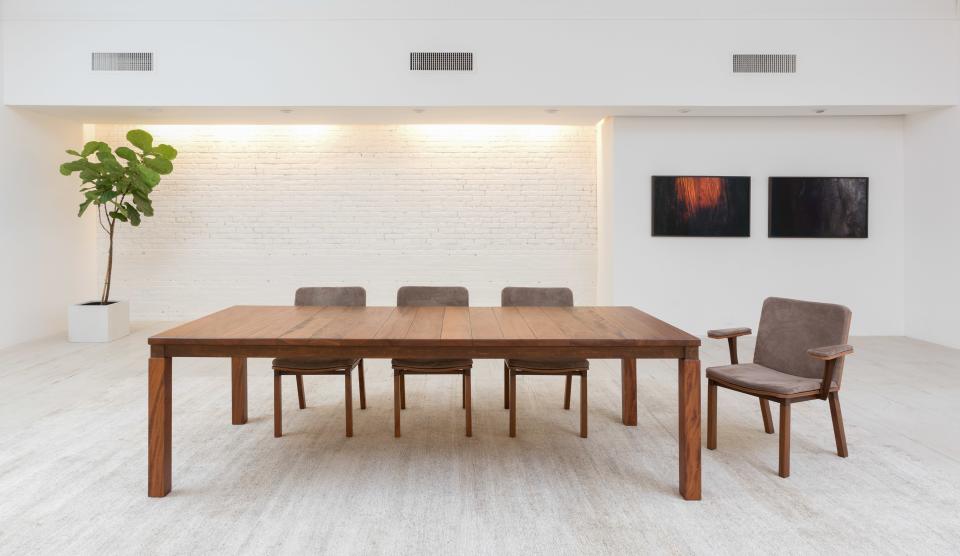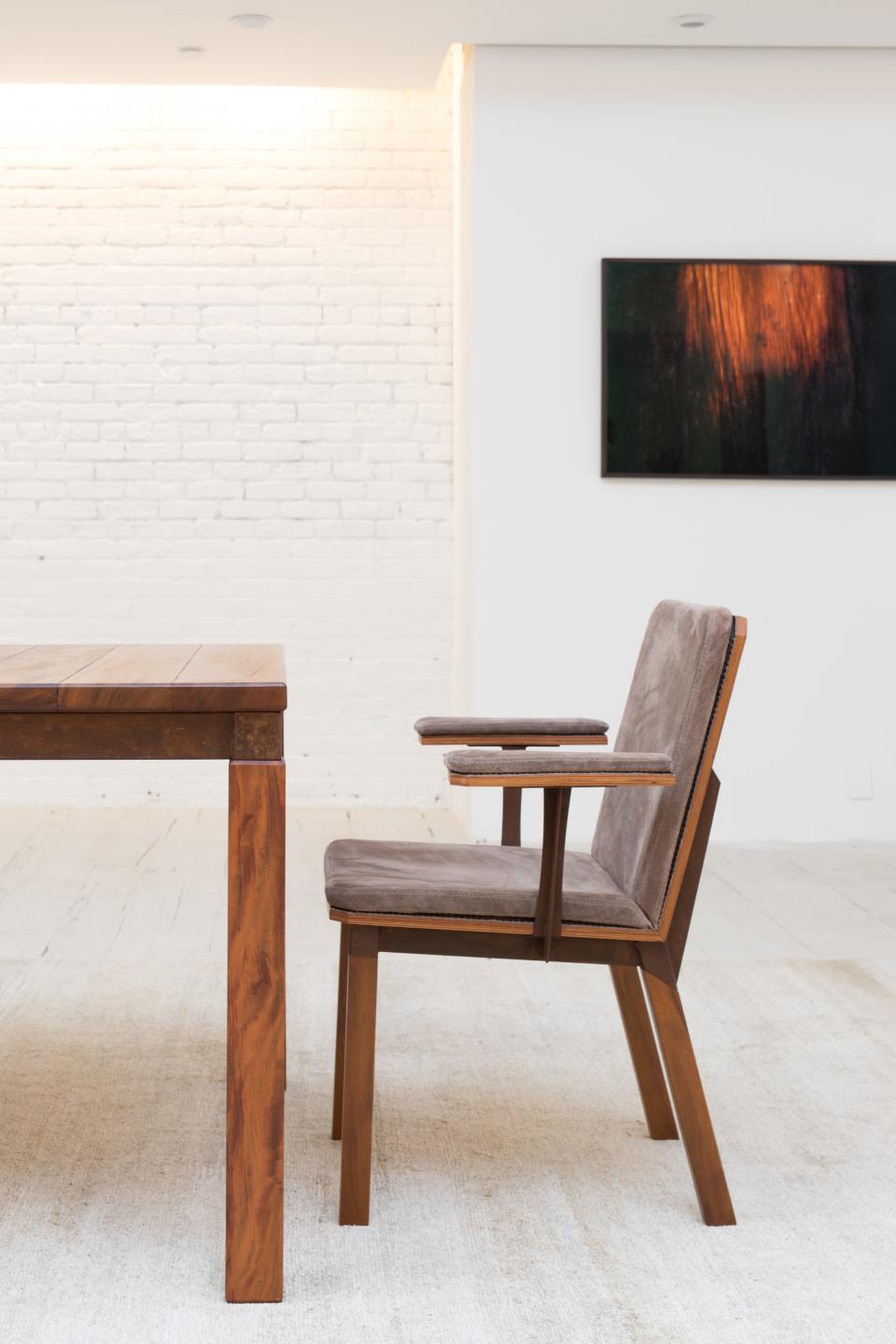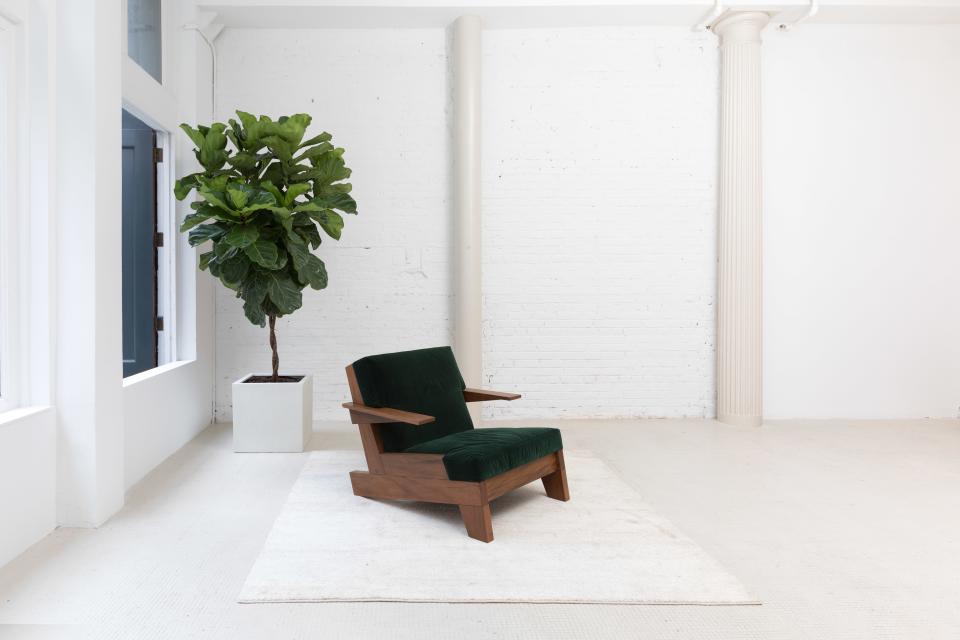Espasso Debuts a Collaboration with Carlos Motta 16 Years in the Making
Tuesday morning at Espasso's Annex space on Franklin Street, Carlos Junqueira and Carlos Motta—amusingly both outfitted in notably similar black jeans and gray t-shirts—are fiddling with a sign in the window. "In the center will be much better," says Junqueira, the gallery's proprietor, while Motta moves the taped sign to a bottom corner and says, "Isn't this better?" The two break into Portuguese, then walk outside to view the sign in question from the street.
It's the kind of playfully nagging banter that only exists among siblings or very close collaborators—though they seem to have the relationship of the former, the two Carloses are the latter, to put it mildly. The sign they're discussing is for Espasso + Motta, a new show of the Brazilian architect and designer's furniture at the gallery that has been his champion in the U.S. The six-piece collection it will debut on Wednesday night is some 16 years in the making, a product of the intense working relationship between Motta and Junqueira, a relationship that chronicles Espasso's existence—and, it could be argued, the very presence of Brazilian design in the U.S.
"16 years ago, I decided that Brazilian design should have more of a representation in this country," Junqueira says of Espasso's beginnings. "Of course, I didn't know anything about it, but I knew that this guy, back in the day, that was the guy that was the best chair guy. All his chairs were comfortable. Everyone said, ‘you have to have a chair by Carlos Motta.’ So I went to Brazil."
Here Motta interjects: "I was the first one you visited, no?"
"Yeah," Junqueira says. "We talked and he was the one who kind of guided me, told me which designers we should consider. He thought it would be nice to be a group together. Since then, I learned a lot from him, but there is one thing I’ll never forget. Right when we started, he said, nobody knows Brazilian design outside of Brazil yet. One thing that is very important is the stigma. If you don’t do it properly, everyone will get the wrong first perception. So that's the story."

From there, Junqueira went on to largely tell that story through Espasso, becoming one of—if not the—the most trusted dealers in Brazilian furniture in the country. Throughout that time, he worked closely with Motta, importing his outdoor furniture to sell, but also using him as a resource and source of education—both things Motta says Junqueira returned.
"We learned together," Junqueira says. "The market, but also certain specific things, like how wood reacts."
Motta chuckles. "Remember the first table?"
"Oh yeah," Junqueira responds with a laugh.
"I had the most beautiful table," Motta says. "I thought, ‘I’m going to send that to Carlos.’ It was dray wood, I thought it would be fine."
"I opened the crate and it had completely split," says Junqueira. "So we’ve learned a lot over time. I think that’s what’s important about the group. We were all learning together."
Once Motta's outdoor furniture had taken off in the U.S. market, Junqueira wanted to bring the collection indoors. For Motta, though, that meant much more than just adapting existing shapes. His practice is intensely experimental; Motta thrives on testing new shapes and materials, and executes each piece through an intense process of design vision married with trial and error.
"I’m an architect and I have my woodshop with my studio," says the designer. :In one space I do the architecture, design, have the woodshop. Everything is very holistically together."

When I ask him how he defines his style, Motta pauses. "You know, it's not really about aesthetic at the beginning of the process," he says. Gesturing to an elegant dining chair in the new line: "Let’s talk about a seat like this. I start from the ergonomic part. I know I have to get the right angle to be comfortable for sitting at a table, eating, studying. That’s the beginning of the design. From then, I get into drawings of the structure, then to the materials. So this process ends up in an interesting aesthetic. But it’s all based on the posture. When you put that all together it creates the aesthetic. It’s never the opposite."
Another ever-present factor in Motta's design: Sustainability. It's something that's informed his practice since the 1970s, after a visit to the Amazon rainforest. "I went to the Amazon, I remember the first time, I saw these huge trees and the people cutting them down," he recalls. "And I cried. You can’t imagine the giant sound. It echoes through the forest. So I said, ‘no way. I have to reclaim.'"

Since then, he's used all reclaimed or FSC-certified woods which, in the new collection, he pairs with metal and upholstery fabrics in surprisingly soft textures (many, like a supple suede on the otherwise industrial-feeling dining chairs, at the urging of Junqueira). Of course, they're all created with comfort first in mind.
"We are a very warm country," Junqueira says of Brazil. "We are trying here to give the lifestyle we have, that Americans don’t have. I have a client that said, ‘your chairs are too comfortable. I’m not used to having people stay after 9 for dinner.’ In Brazil, we love to sit around the table drinking wine for hours. So the idea is that when somebody comes here they can get a sense of what the culture is."
It's that cultural bridge that the two men feel connects all the furniture from their home country, regardless of era or style. "One of the most important things that Carlos did is to show vintage from Brazil," Motta says. "Because when you go downstairs and you get the vintage and you see that alongside my work or work of my colleagues, you see the very close connection. Me, I’m a surfer, I live by the warer. Another designer lives in the mountains. It doesn't matter. We have something aligned that brings us all together, even with that furniture from 30, 40, 50 years ago. It gives a better understanding. And that’s a responsibility for the younger generation. They have a story to complete."
Espasso + Motta goes on view Wednesday, September 12 at the Espasso Annex, 186 Franklin Street.
More from AD PRO: Has Instagram Made Design Shows Better?
Sign up for the AD PRO newsletter for all the design news you need to know

